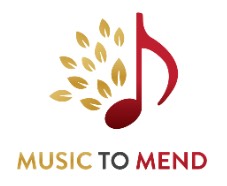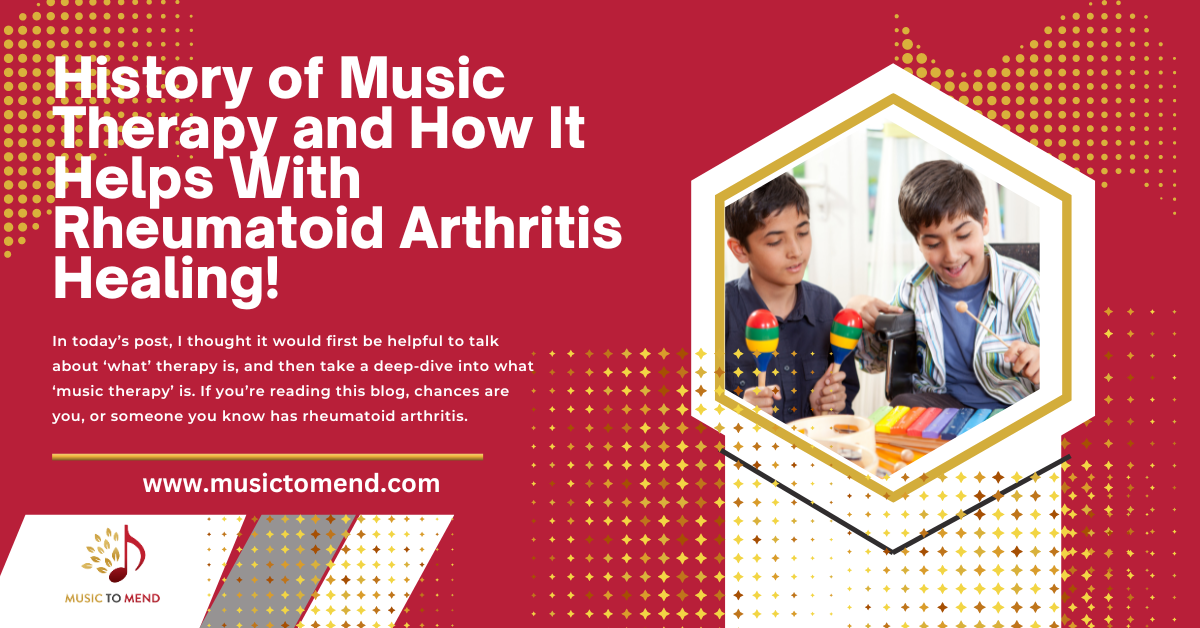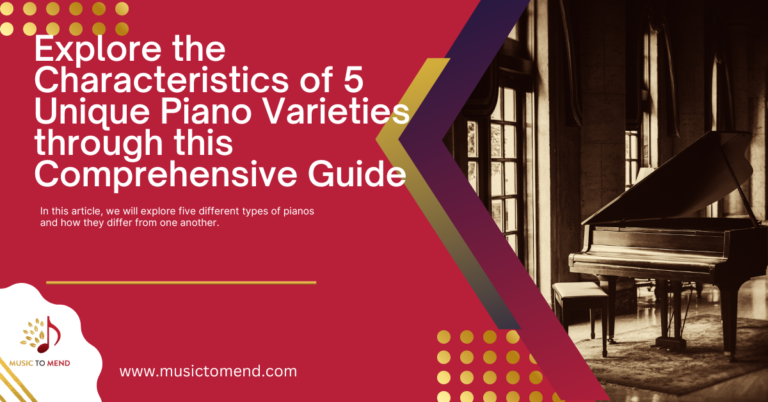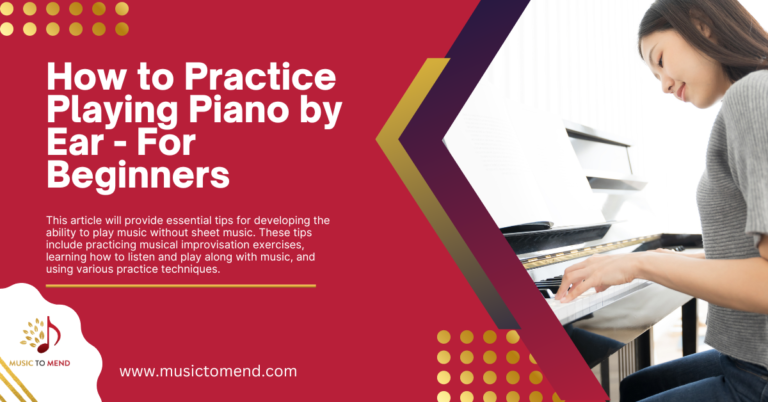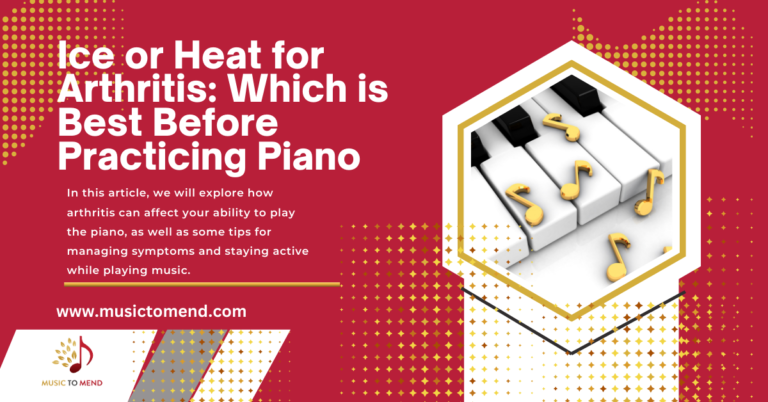History of Music Therapy and How It Helps With Rheumatoid Arthritis Healing!
In today’s post, I thought it would first be helpful to talk about ‘what’ therapy is, and then take a deep-dive into what ‘music therapy’ is. If you’re reading this blog, chances are you, or someone you know has rheumatoid arthritis. Throughout my own journey with rheumatoid arthritis, I realize that many people I ran into didn’t know the difference between rheumatoid arthritis and osteoarthritis. There’s a lot of information out there on the subject, and yet many still don’t realize that RA is an autoimmune disease: such as Lupus, psoriatic arthritis and others.
So let’s dive in and discuss the history of music therapy and how it could help you in your RA healing and wellness journey.
What is Therapy and How Does it Help?
Therapy is a process of psychological treatment used to help individuals overcome challenges and develop healthier ways of managing their emotions, thoughts, and behaviors. It is a form of psychotherapy that involves talking with a trained therapist or counselor to identify issues, explore feelings, set goals, and create strategies for achieving those goals. There are various types of therapy available, including cognitive-behavioral therapy (CBT), psychodynamic therapy (PDT), dialectical behavior therapy (DBT), interpersonal therapy (IPT), and eye movement desensitization and reprocessing (EMDR). Each type of therapy has its own focus and uses different techniques to help individuals achieve their desired outcomes.
Music therapy is a type of psychotherapy that uses music to improve the physical, mental, and emotional well-being of individuals. It has been used for centuries to treat a variety of conditions, from depression and anxiety to chronic pain and dementia. Music therapy is based on the belief that music can be used as an effective tool for healing and improving overall health. This article will provide an overview of music therapy history, what it is, how it works, and its potential benefits.
Tracing Back the Origins of Music Therapy Through the Ages
Music therapy has been used as a form of healing for centuries, with evidence of its use stretching back to ancient times. From the traditional methods of using sound and music to heal physical and mental ailments, to the more modern approach of using music as an aid in therapy, music has been used for its therapeutic effects for many generations. Music has been used for healing and well-being since ancient times. From traditional music healing practices in East Asian cultures to the use of music in Greek medicine, there is a long history of using music for its healing properties. Ancient cultures used musical instruments and chants for a variety of healing rituals. These rituals were believed to improve physical health, mental clarity, emotional balance, and spiritual well-being.
Greek medicine and music, as well as other ancient healing rituals have been passed down through cultures around the world. Healing and music have a long history together. It is well documented that music has been used in ancient cultures for healing and well-being, from the time of Hippocrates to modern-day practices such as Music Therapy. Music therapy is based on scientific research and centuries of tradition, making it an effective form of personal or group support for mental health conditions such as anxiety, depression, bipolar disorder, and post-traumatic stress disorder (PTSD). Over time musical healing has been used by many different cultures around the world with varying levels of success.
The Rise in Popularity & Benefits of Music Therapy in Modern Times
Music therapy is becoming increasingly popular in modern times as a form of therapy for physical and mental health. It has been used for centuries to help people cope with stress, anxiety, depression, and other mental health issues.
Music therapy combines the therapeutic effects of sound and vibrations to help people relax, reduce stress levels, improve moods, and increase focus. It can also be used to help individuals with physical disabilities or chronic illnesses manage their pain.
The modern methods of music therapy are safe and effective for all age groups, from children to adults. The benefits include improved sleep quality, improved moods and emotional wellbeing, increased self-awareness and self-confidence, decreased anxiety levels, better concentration skills, increased creativity levels, increased relaxation response time in the body and mind.
How Different Types Of Music Therapy Can Help With Mental & Physical Health Problems

Music therapy is an evidence-based form of therapy that uses music to improve mental and physical health. It has been used to help people with a wide range of conditions such as depression, anxiety, PTSD, autism, and even physical pain. Music therapy can be divided into different types depending on the type of health issue being addressed. Each type of music therapy has its own set of techniques and strategies that can be used to help individuals cope with their mental and physical health problems. In this article we will explore the different types of music therapy that are available for mental and physical health issues, as well as the potential benefits they offer.
Exploring the Relationship Between Depression and Chronic Pain

Chronic pain can have a profound psychological effect on an individual, and it can lead to depression. Research has shown that people who suffer from chronic pain are more likely to experience depression than those without chronic pain. Music therapy has been used as a form of treatment for mental health disorders such as depression for decades. Recent research has shown that music therapy can be an effective tool in treating depression, providing both psychological and physiological benefits. Music therapy has been found to reduce symptoms of depression, improve mood, and even increase the production of serotonin in the brain.
The Benefits of Combining Other Therapies With Music Therapy
Music therapy is a powerful form of healing that has been used for centuries to promote physical and mental well-being. But when combined with other therapies, it can be even more effective. Mindfulness meditation and healing sound therapies, aromatherapy and sound healing, and physical exercise combined with listening can all have powerful effects on our health. By combining these therapies, we can create a holistic approach to healing that will help us reach our goals faster and more effectively.
What is an Autoimmune Disease?
Autoimmune diseases are a group of disorders in which the body’s immune system mistakenly attacks healthy cells and tissues. These diseases can affect almost any part of the body, including the skin, joints, organs, and more. They are usually chronic conditions that require long-term medical care. Common autoimmune diseases include type 1 diabetes, rheumatoid arthritis, psoriasis, lupus, multiple sclerosis and inflammatory bowel disease. Understanding autoimmunity is key to understanding how to manage these conditions and prevent further complications. But introducing music therapy into our lives makes our symptoms easier to manage.
Common Symptoms of Autoimmune Diseases
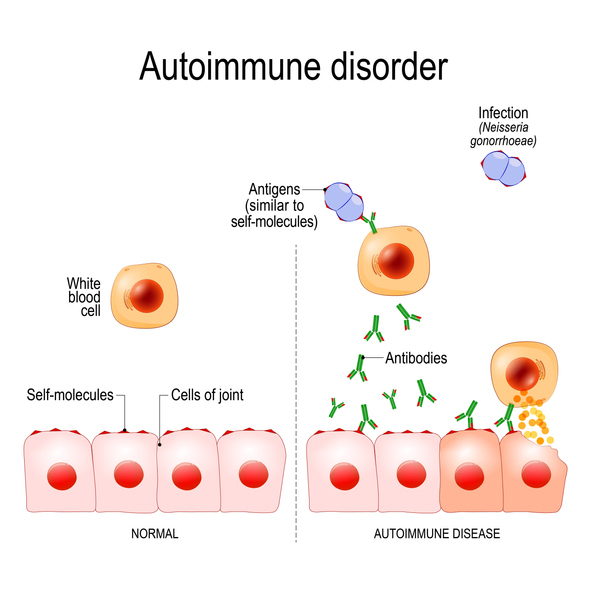
Autoimmune diseases are a group of conditions in which the body’s immune system mistakenly attacks healthy tissue. This can lead to a wide range of symptoms, including fatigue, joint pain, rashes, and more. It is important to be aware of the common signs and symptoms of an autoimmune disease so that you can seek medical help if necessary.
Common symptoms of autoimmune diseases include fatigue, muscle aches and pains, joint pain or swelling, skin rashes or lesions, fever or chills, abdominal pain or bloating, and difficulty concentrating. Other signs may include hair loss or changes in hair texture; swollen lymph nodes; mouth sores; vision problems; numbness or tingling in hands and feet; and unexplained weight loss. If you experience any of these symptoms for an extended period of time it is important to consult your doctor for further evaluation.
Types of Music That Can Help Reduce Chronic Pain & Enhance Relaxation
Music has been used for centuries as a tool to help reduce stress and anxiety, and it can also be used to help reduce chronic pain. Research has shown that certain types of music can help to reduce pain levels, improve mood, and even increase relaxation. Classical music is one of the most popular types of music for relaxation and healing pain, but there are many other genres that can be used to achieve the same effects. In this article, we’ll explore the different types of music that can help reduce chronic pain and enhance relaxation. We’ll also discuss how these types of music can be used in combination with other treatments such as massage therapy or yoga in order to provide additional relief from chronic pain.
What Are The Risk Factors For Hereditary Autoimmune Disease?
Hereditary autoimmune disease is a condition in which a person’s immune system attacks their own body’s healthy cells and tissues. This can lead to serious health problems, such as organ damage, inflammation, and even death. While the exact cause of this condition is unknown, there are certain risk factors that may increase the likelihood of developing it. These include environmental factors such as exposure to toxins or pollutants, lifestyle habits such as smoking or excessive alcohol consumption, family history of autoimmune diseases, and certain genetic mutations. In this article we will discuss the environmental and lifestyle risk factors associated with hereditary autoimmune disease.
Risk Factors for Developing an Inherited Autoimmune Disease
Inherited autoimmune diseases are a group of disorders that affect the body’s immune system. These diseases occur when the body’s immune system mistakenly attacks its own healthy cells and tissues, leading to chronic inflammation and damage. While there is no known cure for these conditions, understanding the risk factors associated with them can help in early diagnosis and treatment.
The most significant risk factor for developing an inherited autoimmune disease is family history. Certain environmental triggers such as exposure to certain toxins or allergens may also increase the risk of developing an inherited autoimmune disorder. Additionally, lifestyle factors such as smoking, alcohol consumption, obesity, and stress can also increase one’s risk of developing an inherited autoimmune disorder.
Identifying the Benefits of Playing the Piano for Arthritis

Playing the piano can be beneficial for those suffering from arthritis. Music therapy has been proven to help reduce pain and improve joint function in arthritic joints. It also has physical benefits such as improved posture, increased flexibility and improved circulation. Additionally, playing the piano can provide psychological benefits such as reducing stress and anxiety levels which can help to reduce arthritic pain. This article will explore the various ways in which playing the piano can benefit those with rheumatoid arthritis.
If you’d like more information on the benefits of playing piano with arthritis, please click here to watch the video.
I truly hope you found this article helpful, and if you learned something new, that’s even better! If you’re suffering from chronic pain, depression or anxiety, I hope you decide to harness the beautiful power and energy to help you heal and thrive.
Until next time, happy music-making and stay well.
Bea
